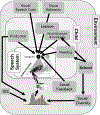The acquisition of speech categories: Beyond perceptual narrowing, beyond unsupervised learning and beyond infancy
- PMID: 38425732
- PMCID: PMC10904032
- DOI: 10.1080/23273798.2022.2105367
The acquisition of speech categories: Beyond perceptual narrowing, beyond unsupervised learning and beyond infancy
Abstract
An early achievement in language is carving a variable acoustic space into categories. The canonical story is that infants accomplish this by the second year, when only unsupervised learning is plausible. I challenge this view, synthesizing five lines of developmental, phonetic and computational work. First, unsupervised learning may be insufficient given the statistics of speech (including infant-directed). Second, evidence that infants "have" speech categories rests on tenuous methodological assumptions. Third, the fact that the ecology of the learning environment is unsupervised does not rule out more powerful error driven learning mechanisms. Fourth, several implicit supervisory signals are available to older infants. Finally, development is protracted through adolescence, enabling richer avenues for development. Infancy may be a time of organizing the auditory space, but true categorization only arises via complex developmental cascades later in life. This has implications for critical periods, second language acquisition, and our basic framing of speech perception.
Figures







Similar articles
-
Infant Phonetic Learning as Perceptual Space Learning: A Crosslinguistic Evaluation of Computational Models.Cogn Sci. 2023 Jul;47(7):e13314. doi: 10.1111/cogs.13314. Cogn Sci. 2023. PMID: 37462237
-
Lexical Learning May Contribute to Phonetic Learning in Infants: A Corpus Analysis of Maternal Spanish.Cogn Sci. 2018 May 21:10.1111/cogs.12620. doi: 10.1111/cogs.12620. Online ahead of print. Cogn Sci. 2018. PMID: 29785714 Free PMC article.
-
Do Infants Really Learn Phonetic Categories?Open Mind (Camb). 2021 Nov 1;5:113-131. doi: 10.1162/opmi_a_00046. eCollection 2021. Open Mind (Camb). 2021. PMID: 35024527 Free PMC article.
-
Sensorimotor foundations of speech perception in infancy.Trends Cogn Sci. 2023 Aug;27(8):773-784. doi: 10.1016/j.tics.2023.05.007. Epub 2023 Jun 9. Trends Cogn Sci. 2023. PMID: 37302917 Review.
-
Listen up! Speech is for thinking during infancy.Trends Cogn Sci. 2014 Dec;18(12):642-6. doi: 10.1016/j.tics.2014.10.001. Epub 2014 Nov 7. Trends Cogn Sci. 2014. PMID: 25457376 Free PMC article. Review.
Cited by
-
Moving away from deficiency models: Gradiency in bilingual speech categorization.Front Psychol. 2022 Nov 24;13:1033825. doi: 10.3389/fpsyg.2022.1033825. eCollection 2022. Front Psychol. 2022. PMID: 36507048 Free PMC article.
-
Brain-Inspired Multisensory Learning: A Systematic Review of Neuroplasticity and Cognitive Outcomes in Adult Multicultural and Second Language Acquisition.Biomimetics (Basel). 2025 Jun 12;10(6):397. doi: 10.3390/biomimetics10060397. Biomimetics (Basel). 2025. PMID: 40558367 Free PMC article. Review.
-
The myth of categorical perception.J Acoust Soc Am. 2022 Dec;152(6):3819. doi: 10.1121/10.0016614. J Acoust Soc Am. 2022. PMID: 36586868 Free PMC article. Review.
References
-
- Albareda-Castellot B, Pons F, & Sebastián-Gallés N. (2011). The acquisition of phonetic categories in bilingual infants: New data from an anticipatory eye movement paradigm. Developmental Science, 14(2), 395–401. - PubMed
-
- Andruski JE, Blumstein SE, & Burton MW (1994). The effect of subphonetic differences on lexical access. Cognition, 52, 163–187. - PubMed
-
- Apfelbaum KS, Kutlu E, McMurray B, & Kapnoula E. (submitted). Don’t Force It! Gradient Speech Categorization Calls for Continuous Categorization Tasks. Journal of the Acoustical Society of America, https://psyarxiv.com/7w93f/. - PMC - PubMed
-
- Benders T. (2013). Nature’s distributional-learning experiment The University of Amsterdam]. Amsterdam, The Netherlands.
Grants and funding
LinkOut - more resources
Full Text Sources
